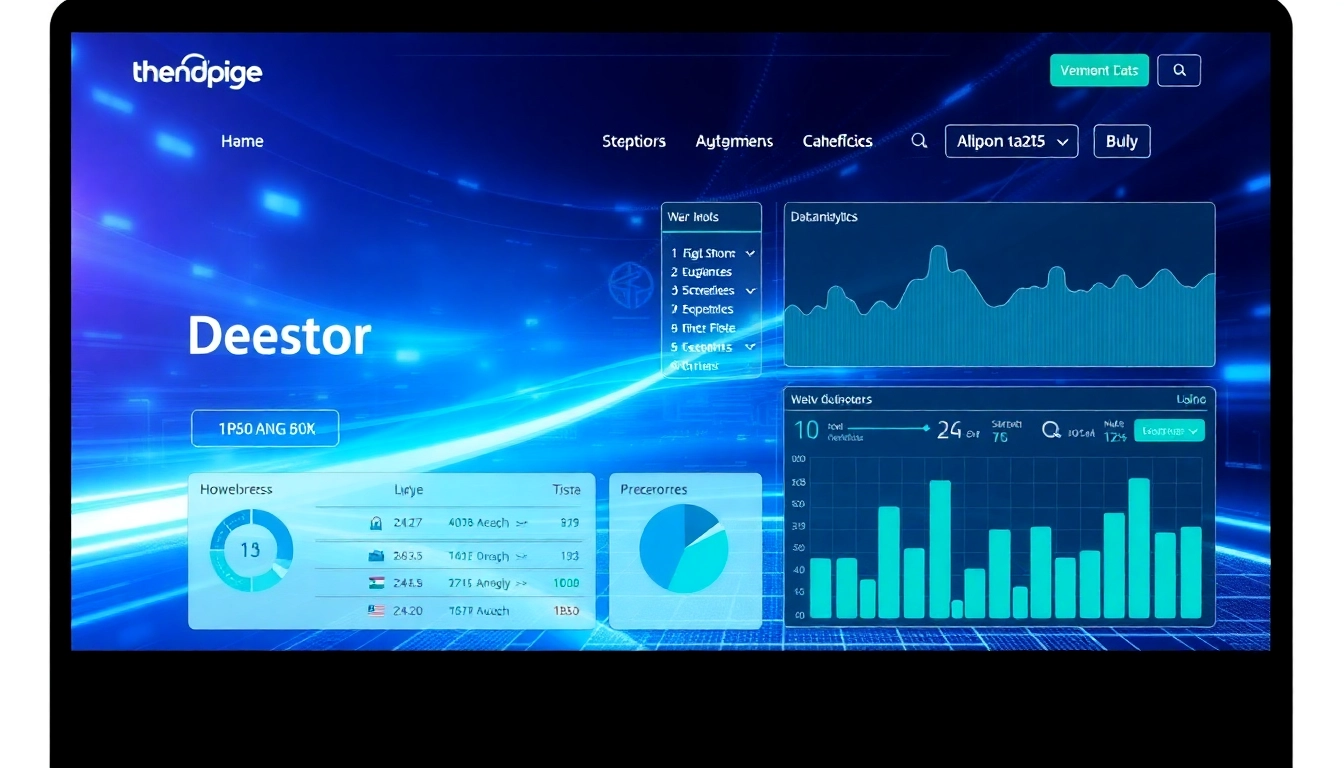Understanding Site Reliability Engineering
In today’s digital landscape, ensuring the reliability and performance of applications is more crucial than ever. This is where the role of Site reliability engineering experts comes into play. These specialists focus on creating and maintaining scalable, efficient systems that support the rapid pace of development and user demands. Site Reliability Engineering (SRE) combines software engineering practices with IT operations to enhance the reliability, availability, and performance of services while also improving the overall efficiency of operations.
What are Site Reliability Engineering Experts?
Site Reliability Engineers are highly skilled professionals who intertwine system engineering and software development methodologies. They are tasked with automating operational tasks to build more reliable systems and reduce the burden of manual intervention. SREs ensure that services have up-time reliability so that users can depend on them consistently. Their primary goal is to create scalable and highly reliable software systems that can withstand traffic spikes and operational challenges.
The Role of Site Reliability Engineering in Modern Businesses
As businesses increasingly leverage technology to drive their operations, the need for reliability becomes paramount. Modern applications often operate in complex environments where failures can lead to significant outages or performance degradation. SREs play a pivotal role in identifying weaknesses in systems and implementing best practices that enhance reliability. By focusing on aspects such as service level objectives (SLOs) and service level agreements (SLAs), they ensure that performance meets customer expectations and business requirements.
Key Skills of Site Reliability Engineering Experts
To be effective in their roles, Site Reliability Engineering experts must possess a diverse skill set that includes:
- Programming Skills: Proficiency in programming languages, such as Python, Go, or Java, is essential for automating tasks and creating reliable systems.
- System Administration: Understanding server management, cloud services, and databases is critical for maintaining infrastructure.
- Monitoring and Incident Response: SREs must utilize various tools to monitor system performance and respond swiftly to incidents, minimizing downtime.
- Collaboration and Communication: Strong interpersonal skills are necessary to work with cross-functional teams and communicate technical issues effectively.
- Understanding of DevOps Principles: A solid grasp of DevOps practices helps SREs create seamless workflows that bridge development and operations.
Best Practices for Site Reliability Engineering
Implementing Reliability Metrics
Establishing reliable metrics is foundational to Site Reliability Engineering. By defining and measuring key performance indicators (KPIs), such as availability, latency, error rates, and capacity utilization, organizations can monitor the health of their systems. A common metric used is the Service Level Indicator (SLI), which provides quantifiable data indicating the performance of a service. Building Service Level Objectives (SLOs) from established SLIs helps set reliability goals that teams can strive to achieve.
Automation Strategies for Successful Operations
Automation lies at the core of improving efficiency within site reliability engineering. From deploying code to monitoring system status, automating routine tasks can significantly reduce human error and enhance operational speed. Automated testing frameworks can ensure that code changes do not introduce new errors. Continuous Integration/Continuous Deployment (CI/CD) pipelines also facilitate rapid updates and improvements, allowing teams to push changes seamlessly while maintaining service reliability.
Incident Management and Response Techniques
Managing incidents effectively is a crucial skill for SREs. Establishing a well-defined incident management process allows teams to respond to issues promptly and minimize service disruption. Key components of effective incident management include:
- Incident Detection: Using monitoring tools to identify and alert teams of potential issues quickly.
- Response Plans: Developing predefined response protocols for recurring issues or severe incidents to facilitate quicker resolution.
- Postmortems: Conducting detailed post-incident reviews to understand root causes and prevent future occurrences is vital for continuous improvement.
Common Challenges Faced by Site Reliability Engineering Experts
Balancing Reliability and Speed
One of the fundamental challenges in SRE is finding the balance between reliability and the speed of deployment. While reliability is crucial, the pressure to quickly release new features can compromise it. SREs must advocate for a culture where reliability is a shared responsibility among all team members, encouraging practices such as prioritizing testing and considering reliability in the design phase of new features.
Overcoming Communication Barriers
Effective communication is essential for SRE success, especially when coordinating between development and operations teams. Barriers can arise from differing priorities and terminologies used across teams. Establishing common goals and fostering a collaborative environment can significantly reduce friction. Utilizing tools that facilitate transparent communication, such as incident management platforms and shared dashboards, can help maintain alignment among teams.
Managing Complex Systems and Infrastructure
Modern systems are increasingly complex, comprising diverse components running in various environments. This complexity often introduces challenges in reliability, monitoring, and maintenance. SREs must leverage sophisticated tools and practices to manage this complexity effectively. Techniques such as microservices architecture, containerization, and robust configuration management practices can help simplify management while enabling scalability.
Tools and Technologies for Site Reliability Engineering
Essential Software and Platforms
The selection of tools is pivotal for SRE success. Essential software includes monitoring tools like Prometheus and Grafana, which provide insights into system performance. Configuration management tools such as Ansible and Terraform enable teams to automate deployment processes and manage infrastructures as code. Additionally, incident management tools like PagerDuty and Opsgenie assist in orchestrating incident responses efficiently.
Monitoring Tools for Performance Insights
Effective monitoring is at the heart of Site Reliability Engineering. SREs must utilize various monitoring solutions to gain visibility into system performance. Common tools for monitoring include:
- Application Performance Monitoring (APM): Tools like New Relic and Dynatrace track application behavior, user experience, and performance issues.
- Infrastructure Monitoring: Solutions like Nagios and Datadog provide insights into server health, resource usage, and potential bottlenecks.
- Log Management: Tools like ELK Stack (Elasticsearch, Logstash, Kibana) or Splunk allow teams to analyze logs for troubleshooting and understanding application behavior.
Continuous Integration and Delivery in SRE
CI/CD practices play a critical role in enhancing reliability and speeding up software delivery. Implementing CI/CD pipelines allows teams to automate testing and deployment processes, which can significantly reduce the risk of deploying new features. Strategies such as Canary Releases and Blue-Green Deployments enable gradual rollout processes, ensuring that new changes can be closely monitored and rolled back if necessary, reinforcing system reliability.
The Future of Site Reliability Engineering
Emerging Trends and Technologies
The future of Site Reliability Engineering is set to be influenced by several emerging trends and technologies. Artificial Intelligence for IT Operations (AIOps) is gaining traction, enabling teams to analyze large volumes of data quickly and automate decision-making processes. Furthermore, the rise of serverless computing allows organizations to focus on producing code without managing infrastructure complexities, enhancing resource efficiency and scalability.
The Importance of Continuous Learning
As technology evolves, embracing a culture of continuous learning is paramount for SREs. Engaging in ongoing training, attending workshops, and participating in conferences can help them stay current with the latest trends, tools, and best practices. Encouraging knowledge sharing through internal forums or mentorship programs can foster growth and improve team efficiency.
Building a Cultured Team of Site Reliability Engineering Experts
Creating a strong culture centered around the principles of Site Reliability Engineering is critical for success. This can be achieved by emphasizing collaboration, encouraging experimentation, and instilling a sense of accountability among team members. Fostering an environment that promotes open communication and recognizes both successes and failures can enhance team cohesion and drive continuous improvement in reliability practices.



